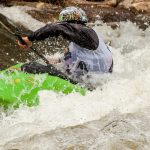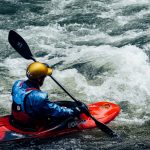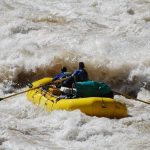We understand how foolish, irresponsible, and illegal it is to consume alcohol and operate a vehicle.
What about kayaks, though?
Is consuming alcoholic beverages while kayaking as hazardous as operating a motor vehicle while drunk? Is kayaking after drinking alcohol even allowed? Can you be charged with a Driving Under the Influence offense while operating a kayak?
In a nutshell: yes, it is legally possible to be charged with driving under the influence (DUI) while operating a kayak. Nonetheless, it is still important to be aware of the potential consequences of boating while intoxicated.
What Is A BUI? Kayaking Version Of “Driving Under The Influence”
When “DUI” is thought of, the most common association is driving under the influence of alcohol since it is a crime to have a blood alcohol content over the legal limit while operating a vehicle.
But contrary to popular belief, driving or, in this case, boating under the influence is not limited to alcohol consumption:
Alcohol is only part of the BUI law equation. You can face BUI (boating under the influence) charges if you are operating a vessel while under the influence of a substance that would impede your capability to operate it properly and safely.
This encompasses booze, illegal substances, and even some legally prescribed medicines.
So, whatever you choose to call it – BUI (boating under the influence), BWI (boating while intoxicated), or even the standard DUI (driving under the influence) – it means the same thing:
Operating a ship while sober is a legal requirement; consuming alcohol or other substances while doing so is against the law.
What’s the Difference Between BUI and BWI?
Legally speaking, a BUI and BWI are one and the same. These two offenses are both subject to the same state and federal rules, and the consequences for being found guilty are also the same.
The only difference is in the terminology itself:
- BUI stands for “boating under the influence,” while
- BWI stands for “boating while intoxicated.”
In some regions, there may be a preference for one word over another, though the definitions are equivalent and the regulations consistent.
USA Kayak BUI Laws
Some kayakers maintain that they are exempt from boating while intoxicated regulations – they think the regulations apply solely to motor boats or crafts larger than a designated size. However, this is not the case;
In all 50 states of the US, it is against the law to be operating a vessel while under the influence of alcohol and any infringement of this law is subject to the US Coast Guard’s federal regulations with stringent punishments for those breaking the BUI (Boating Under the Influence) legislation.
Most states have a legal blood alcohol level of 0.08%, except for North Dakota and Wyoming – where it is 0.1%. This applies to a total of 48 states. It is important to examine the regulations that your state has in issue, but typically, operating a kayak while intoxicated is prohibited as well.
Does your kayak qualify as a “vessel” under BUI laws?
It is not clear what should be classified as a boat according to the law, yet this perplexity does not involve motor-powered vessels.
In other words, no matter if you’re trying to catch fish from a lake in a kayak with a trolling motor or driving a speedy vessel out in the ocean, you’ll be subject to the same regulations. If you are under the influence of alcohol while operating a motorized kayak, you will automatically be charged with a Boating Under the Influence offense.
In most states, laws pertaining to acts on boats do not specifically state that motorized vessels are included or non-motorized ones operated by oars or paddles and manual power vessels such as kayaks are excluded. Instead, the legislation just states that it applies to anyone operating any type of vessel.
The way the law is written makes it open to the interpretation of those responsible for its implementation. This implies that, depending on how the law enforcement in your region interpret the law, you could be handed a BUI charge even if your kayak does not have a motor.
Despite not knowing the law, or understanding it in a way that assumes your form of kayak is not included, you can still be sentenced in court.
Be aware of the open container laws pertaining to water vessels in your state. In some places, it’s permissible to carry an unopened bottle of alcohol on a kayak or vessel as long as it cannot be easily accessed.
In some other states, it is a punishable offense to bring alcohol on a kayak, even if its not being consumed.
Can you drink and kayak?
It is permissible to have alcoholic beverages while kayaking, as long as you are sober enough to be able to paddle the vessel without causing yourself or other people any damage. It is not morally sound to consume alcohol before you embark or while you are travelling down a river.
It is impossible to tell with certainty which beverage will cause impairment or put one over the legal limit. So you’re better off not taking any chances.
Stay sharp and clear-headed by avoiding alcohol completely.
What is the blood alcohol limit for a BUI?
In the United States, the permissible amount of alcohol in a driver’s blood is also the threshold for cycling or piloting a boat.
It is illegal to operate a kayak, whitewater raft, or paddleboard when your blood alcohol content (BAC) is 0.08% or 80 milligrams of alcohol for every 100 milliliters of blood. Operating in this condition diminishes your ability to do so safely.
In certain states, such as Colorado, Wyoming, and North Dakota, the blood alcohol content (BAC) threshold for boating is higher than the standard for motor vehicle operation, at 0.10%. In some states, such as Utah, it is against the law to operate a car or boat if your blood alcohol content is higher than 0.05%.
It’s a good idea to look into the laws about Blood Alcohol Concentration for boaters in your state, as they are liable to change. Make sure you investigate thoroughly to find out the most up-to-date regulations on Boating Under the Influence.
One would usually have to have two drinks in one or two hours to surpass the legal Blood Alcohol Content threshold of 0.08%. According to the National Institute on Alcohol Abuse and Alcoholism, a “drink” is defined as:
- one 5-ounce glass of wine containing 12% alcohol
- one 12-ounce beer containing 5% alcohol
- one 1.5-ounce shot of 80-proof liquor/distilled spirits containing 40% alcohol
One’s BAC or the speed at which one becomes impaired is heavily reliant on numerous elements such as their weight, ethnicity, gender, metabolism, stress state, the food they’ve had that day, and lots of other details.
You won’t be able to tell how much alcohol is in your system without being tested or taking a breathalyzer, which means that even if you don’t feel inebriated, you could still be above the legal limit.
The only way to ensure safety for everyone is to abstain from consuming alcohol before or during a kayaking trip. If you must have an alcoholic beverage, be sure you have plenty of time between your final drink and the start of your rafting adventure. It is expected that for each beverage, at least one hour should pass before consuming another.
Can you get a BUI while high on marijuana or other drugs?
Do not be deceived by phrases like “Do not Drink and Drive”, implying that the legal requirements are limited to driving while inebriated with alcohol. Much like laws for DUIs, rules for BUIs often deem being ‘under the influence’ to refer to drinking alcohol or taking any other type of substance that could impede one’s ability to control their kayak.
This encompasses cannabis, meth, acid, hallucinogenic fungi, and even cough syrup which can cause drowsiness. Think of it this way: if the substance you are using causes you to feel joyful or alter your body’s usual activities, then you are considered to be under its influence.
If you are apprehended while boating while under the influence of alcohol or drugs, you will be subject to a Boating Under the Influence cite.
What are the risks and dangers of drinking and kayaking?
Drinking alcohol before or while kayaking may not appear to be a problem, but it has the potential to rapidly cause huge issues and ruin a previously enjoyable day.
Before you choose to combine boozing and paddling, look at some of the effects that drinking can have on your canoeing.
1. Greater impairment
The chances of becoming intoxicated quicker are higher if you are on a body of water than if you are on solid ground. The combination of the wind, sun, and sea, as well as the effort you put into paddling your kayak can leave you feeling drained and parched, making the effects of alcohol stronger.
You might be capable of having a few beverages over a period of time on dry land and still work normally, yet having the same amount of drinks over the same time span on a kayak can make you more inebriated and seriously debilitated.
2. Higher chance of accidents
Alcohol consumption has been pinpointed as a major contributing factor in lethal boating incidents, as well as speed, distractibility, and lack of experience. The 2020 Recreational Boating Statistics indicate that the leading cause of boating accidents and fatalities was alcohol use.
The Coast Guard cautions strongly that going on the water while impaired can be a risky activity. Boat operators who have a blood alcohol level of 0.10% or more have a much higher risk of dying in a boating accident than individuals who are not intoxicated.
3. Slower reaction time
When kayaking it is essential to remain vigilant and attuned to your surroundings because nature can surprise you. The climate can go from pleasant to volatile in a short amount of time, so it’s important to be aware of potential danger and take steps to ensure you are protected.
However, when consuming alcohol, the brain takes a longer period of time to comprehend data since alcohol is a type of sedative that reduces the rate of the central nervous system. You won’t be aware of things like potential danger, physical discomfort, or fatigue as promptly.
Your attention span will decrease, leaving you with very little time to respond to whatever is occurring. When you respond, the lack of coordination and reduced motor abilities may lead to plenty of errors.
4. Poor vision and balance
The fluid structure of water makes kayaking an unsteady experience compared to traveling by car on solid ground. Drinking alcohol impairs the functioning of the inner ear, making it more likely that one might fall over and flip their kayak.
Drunkenness can also impair your sight and make it hard for you to concentrate your gaze or make sense of what you’re viewing. Being able to take in your environment and comprehend it thoroughly is critical in order to ensure your protection and endurance when kayaking or participating in other aquatic activities.
5. Lapses in judgment
Alcohol can be a source of confidence when you’re trying to find the nerve to talk to someone you fancy, yet it can be very damaging when used while participating in water-based activities.
Drinking alcohol can make you feel like you are more capable of doing things that you would otherwise avoid without being intoxicated. It can decrease your caution and motivate you to take chances without considering the implications.
6. Increased threat of injury
Drinking alcohol can adversely affect your recollection, estimate how far or near something is, scope of vision, and discernment of colors, all skills that are essential for safety while you’re by, in, or on the water.
Your decreased cognitive functioning and inability to focus can lead to unsafe driving practices and result in accidents.
If you find yourself in a situation where tipping into the water prevents you from getting yourself out of your kayak, the chances of drowning are significantly higher since your swimming skills might not be as proficient.
Drinking alcohol can cause your body’s temperature to drop, which could lead to hypothermia if you accidentally go into cold water and remain there for an extended period of time.
What’s The Penalty For BUI?
In most nations, there are statutes in place regarding driving under the influence (DUI) as well as boating under the influence (BUI). If you are ever seen consuming alcohol while kayaking, you will likely face consequences, although the actual sanctions for operating a boat while under the influence might differ.
If you’re curious about what sort of punishment could result from a BUI (boating under the influence), I can only provide a general idea for you based on various countries.
The Penalty For BUI In America?
In the United States, if you’re convicted of boating under the influence of drugs or alcohol, the penalties are as follows:
- First Offense – First-time offenses are typically treated as misdemeanors that could cost you around $200 to $1000 in fines and land you in even jail for one to six months. You are also likely to have your kayak registration suspended for a period of time
- Second Offense – If you get caught drinking and kayaking the second time, expect the fines to go up to $500 to $2000. You’re also looking at up to 12 months in jail.
- Third Offense (Repeat Offender) – Getting a BUI for the third time means that you’re now considered a repeat offender. Fines will range from $1000 to $3000, with the potential of spending up to two years in jail.
The harshess of penalties for driving while under the influence of either drugs or alcohol can vary depending on the environment. For instance, if someone under the age of majority is present in the boat, or if there is a boating incident which involves other people being hurt or dying, the misdemeanor BUI can be raised to a felony.




